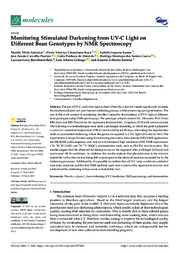Monitoring stimulated darkening from UV-C light on different bean genotypes by NMR spectroscopy.
Monitoring stimulated darkening from UV-C light on different bean genotypes by NMR spectroscopy.
Autoria: SALVADOR, M. V.; KOCK, F. V. C.; SANTOS, I. L.; PAULINO, J. F. C.; ALMEIDA, C. P. de; GARCIA, R. H. S.; BENCHIMOL-REIS, L. L.; COLNAGO, L. A.; FERREIRA, A. G.
Resumo: The use of UV-C cool white light on bean (Phaseolus vulgaris L.) seeds significantly increases the biochemical seed coat post-harvest darkening process, whilst preserving seed germination. The aim of this work consists in monitoring the effect caused by the incidence of UV-C light on different bean genotypes using NMR spectroscopy. The genotype samples named IAC Alvorada; TAA Dama;BRS Estilo and BRS Pérola from the Agronomic Institute (IAC; Campinas; SP; Brazil) were evaluated.The following two methodologies were used: a prolonged darkening, in which the grain is placed in a room at a controlled temperature (298 K) and humidity for 90 days, simulating the supermarket shelf; an accelerated darkening, where the grains are exposed to UV-C light (254 nm) for 96 h. The experiments were performed using the following innovative time-domain (TD) NMR approaches:the RK-ROSE pulse sequence; one- and two-dimensional high resolution (HR) NMR experiments(1H; 1H-1H COSY and 1H-13C HSQC); chemometrics tools, such as PLS-DA and heat plots. The results suggest that the observed darkening occurs on the tegument after prolonged (90 days) and accelerated (96 h) conditions. In addition, the results indicate that phenylalanine is the relevant metabolite within this context, being able to participate in the chemical reactions accounted for by the darkening processes. Additionally, it is possible to confirm that a UV-C lamp accelerates oxidative enzymatic reactions and that the NMR methods used were a trustworthy approach to monitor and understand the darkening in bean seeds at metabolite level.
Ano de publicação: 2022
Tipo de publicação: Artigo de periódico
Unidade: Embrapa Instrumentação
Palavras-chave: Bean darkening, NMR spectroscopy and chemometrics, UV-C irradiation
Observações
1 - Por padrão são exibidas publicações dos últimos 20 anos. Para encontrar publicações mais antigas, configure o filtro ano de publicação, colocando o ano a partir do qual você deseja encontrar publicações. O filtro está na coluna da esquerda na busca acima.
2 - Para ler algumas publicações da Embrapa (apenas as que estão em formato ePub), é necessário ter, no celular ou computador, um desses softwares gratuitos. Sistemas Android: Google Play Livros; IOS: iBooks; Windows e Linux: software Calibre.
Acesse outras publicações
Acesse a Base de Dados da Pesquisa Agropecuária (BDPA) para consultar o acervo completo das bibliotecas da Embrapa.

